Dr. Ted Neal and Alexis Hatvick
Geologic Time
Earth was formed about 4.65 billion years ago. Scientists use the geologic time scale to describe events that have happened throughout Earth’s history.
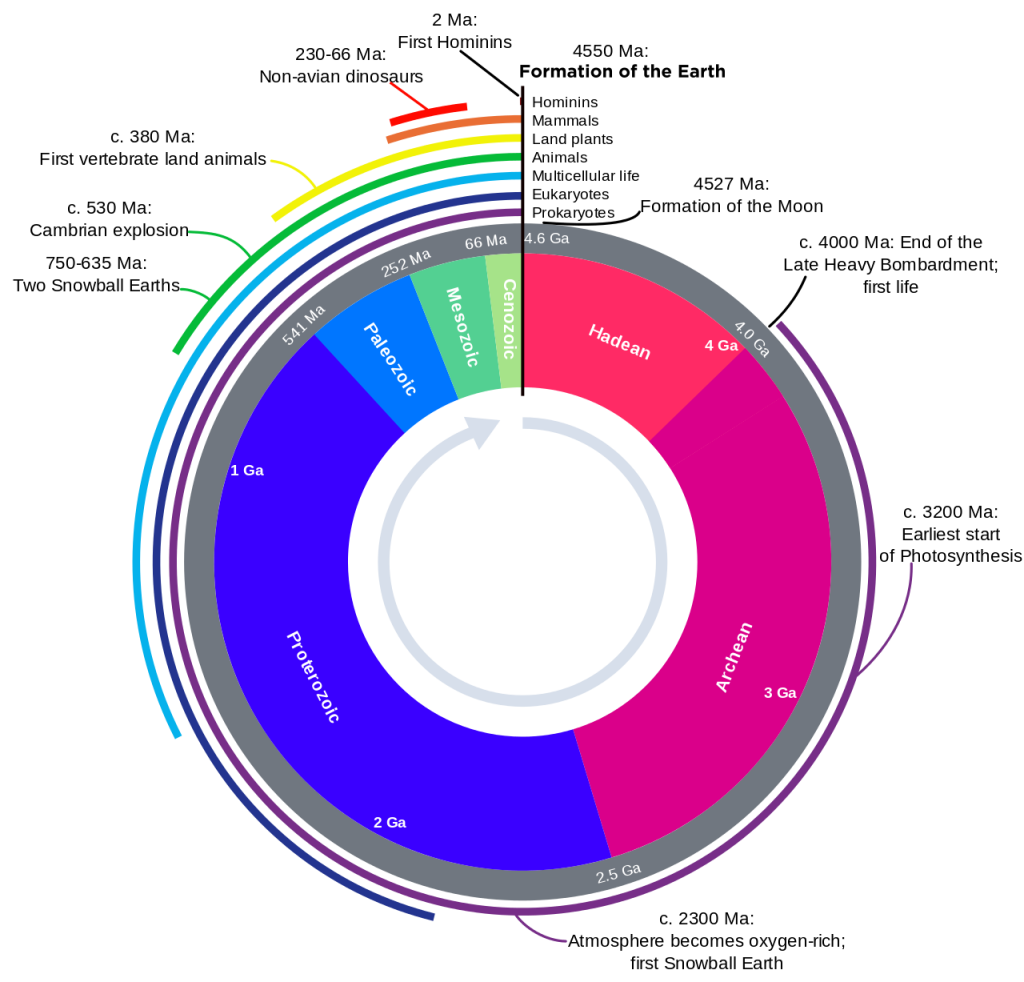
If the entirety of Earth’s history was represented on a clock, humans would appear at 11:59:40 PM.
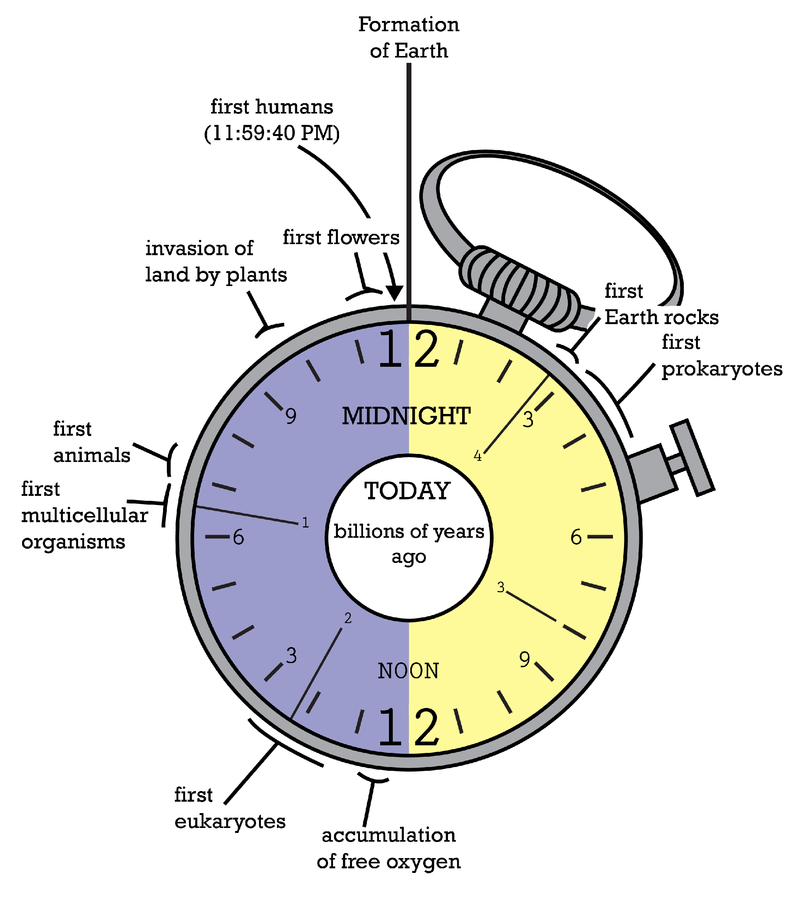
Origins of Life on Earth: Bacteria, Plants, and Animals
- 4.65 billion years ago: Earth is formed
- 4 billion years ago: The first life on Earth was simple, prokaryotic bacteria.
- 600 million years ago: Aquatic plants and animals evolved. It is likely that life originated in water because it offered early organisms more temperature stability compared to land, currents provided early movement, and they didn’t have to fight gravity.
- 500 million years ago: Huge period of evolution and diversification of life known as the Cambrian Period.
- 400 million years ago: Terrestrial plants and animals evolved.
- 65-250 million years ago: Dinosaurs lived during the Mesozoic Era.
- 200,00-300,000 years ago: Homo sapiens, early ancestors of humans, evolved.
Snowball Earth
At least three times in Earth’s history, the planet was engulfed almost entirely in ice–an event called Snowball Earth. These events happened between 580 and 750 million years ago. Evidence for Snowball Earth comes from sedimentary rocks. In a normal ice age, the types of rock deposited by glaciers would be found mostly near Earth’s poles. However, geologists found glacial rocks of similar ages around the world, at both the poles and equatorial regions. This led to the Snowball Earth theory.
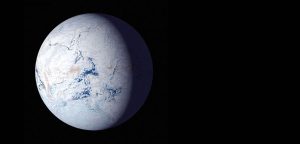
Snowball Earth was caused by a chain of events called a positive feedback loop. Ice has a high albedo and is very insulating, so it is not heated up efficiently by sunlight. As ice accumulated on the planet, it increasingly reflected more sunlight and cooled Earth even further. Thus, this created a cycle of ice formation, increased albedo, and cooling of Earth which continued until the entire planet was covered in ice.
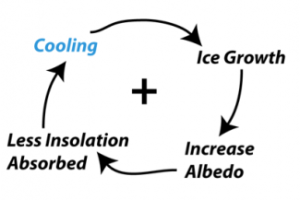
Why is Earth not covered in ice now if the positive feedback loop continues forever? The leading theory is that volcanoes continued erupting during Snowball Earth, emitting high levels of carbon dioxide, which was trapped under the ice. Eventually, the carbon dioxide built up enough to start melting the ice. Ice turned to water, which has a lower albedo and thus absorbed more of the Sun’s energy. This led to a new positive feedback loop that resulted in warming of the planet and the end of Snowball Earth. Additionally, it is believed that bacterial life on Earth survived the harsh conditions during Snowball Earth events by living near the heat sources from volcanoes.
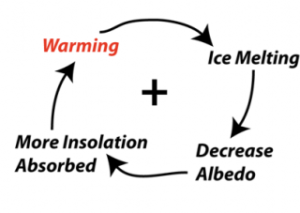
Key Takeaways
Timeline of Earth’s History:

K-6 Standards
2-ESS2-3. Obtain information to identify where water is found on Earth and that it can be solid
or liquid.
NGSS
Performance Expectations
| 2-ESS1-1. | Use information from several sources to provide evidence that Earth events can occur quickly or slowly. [Clarification Statement: Examples of events and timescales could include volcanic explosions and earthquakes, which happen quickly and erosion of rocks, which occurs slowly.] [Assessment Boundary: Assessment does not include quantitative measurements of timescales.] |
|---|
| 2-ESS2-2. | Develop a model to represent the shapes and kinds of land and bodies of water in an area. [Assessment Boundary: Assessment does not include quantitative scaling in models.] |
|---|
| 2-ESS2-3. | Obtain information to identify where water is found on Earth and that it can be solid or liquid. |
|---|
| 4-ESS2-2. | Analyze and interpret data from maps to describe patterns of Earth’s features. [Clarification Statement: Maps can include topographic maps of Earth’s land and ocean floor, as well as maps of the locations of mountains, continental boundaries, volcanoes, and earthquakes.] |
|---|
| 5-ESS2-1. | Develop a model using an example to describe ways the geosphere, biosphere, hydrosphere, and/or atmosphere interact. [Clarification Statement: Examples could include the influence of the ocean on ecosystems, landform shape, and climate; the influence of the atmosphere on landforms and ecosystems through weather and climate; and the influence of mountain ranges on winds and clouds in the atmosphere. The geosphere, hydrosphere, atmosphere, and biosphere are each a system.] [Assessment Boundary: Assessment is limited to the interactions of two systems at a time.] |
|---|
| 5-ESS2-2. | Describe and graph the amounts of salt water and fresh water in various reservoirs to provide evidence about the distribution of water on Earth. [Assessment Boundary: Assessment is limited to oceans, lakes, rivers, glaciers, ground water, and polar ice caps, and does not include the atmosphere.] |
|---|
| MS-ESS2-2. | Construct an explanation based on evidence for how geoscience processes have changed Earth’s surface at varying time and spatial scales. [Clarification Statement: Emphasis is on how processes change Earth’s surface at time and spatial scales that can be large (such as slow plate motions or the uplift of large mountain ranges) or small (such as rapid landslides or microscopic geochemical reactions), and how many geoscience processes (such as earthquakes, volcanoes, and meteor impacts) usually behave gradually but are punctuated by catastrophic events. Examples of geoscience processes include surface weathering and deposition by the movements of water, ice, and wind. Emphasis is on geoscience processes that shape local geographic features, where appropriate.] |
|---|
| MS-ESS2-3. | Analyze and interpret data on the distribution of fossils and rocks, continental shapes, and seafloor structures to provide evidence of the past plate motions. [Clarification Statement: Examples of data include similarities of rock and fossil types on different continents, the shapes of the continents (including continental shelves), and the locations of ocean structures (such as ridges, fracture zones, and trenches).] [Assessment Boundary: Paleomagnetic anomalies in oceanic and continental crust are not assessed.] |
|---|
DCI
Second grade
ESS1.C: The History of Planet Earth
ESS2.B: Plate Tectonics and Large-Scale System Interactions
ESS2.C: The Roles of Water in Earth’s Surface Processes
Fifth Grade
ESS2.A: Earth Materials and Systems
ESS2.C: The Roles of Water in Earth’s Surface Processes
Middle School
ESS2.A: Earth’s Materials and Systems
ESS2.B: PLate Tectonics and Large-Scale System Interactions
ESS2.C: The Roles of Water in Earth’s Surface Processes
Crosscutting Concepts
Patterns
Stability and Change
fifth grade
Scale, Proportion, and Quantity
Systems and System Models
middle school
Patterns
Scale Proportion and Quantity
A period of extreme glaciation where a positive feedback loop led to Earth being covered almost entirely by ice.
A process where one change triggers the next in a continuous cycle that encourages the initial change.
The amount of energy reflected by a surface. Light surfaces tend to have a high albedo because they reflect more energy. Dark surfaces tend to have a low albedo because they absorb more energy.
A vent that allows magma, rock fragments, ash, and gases to escape to the surface of a planet or moon.

